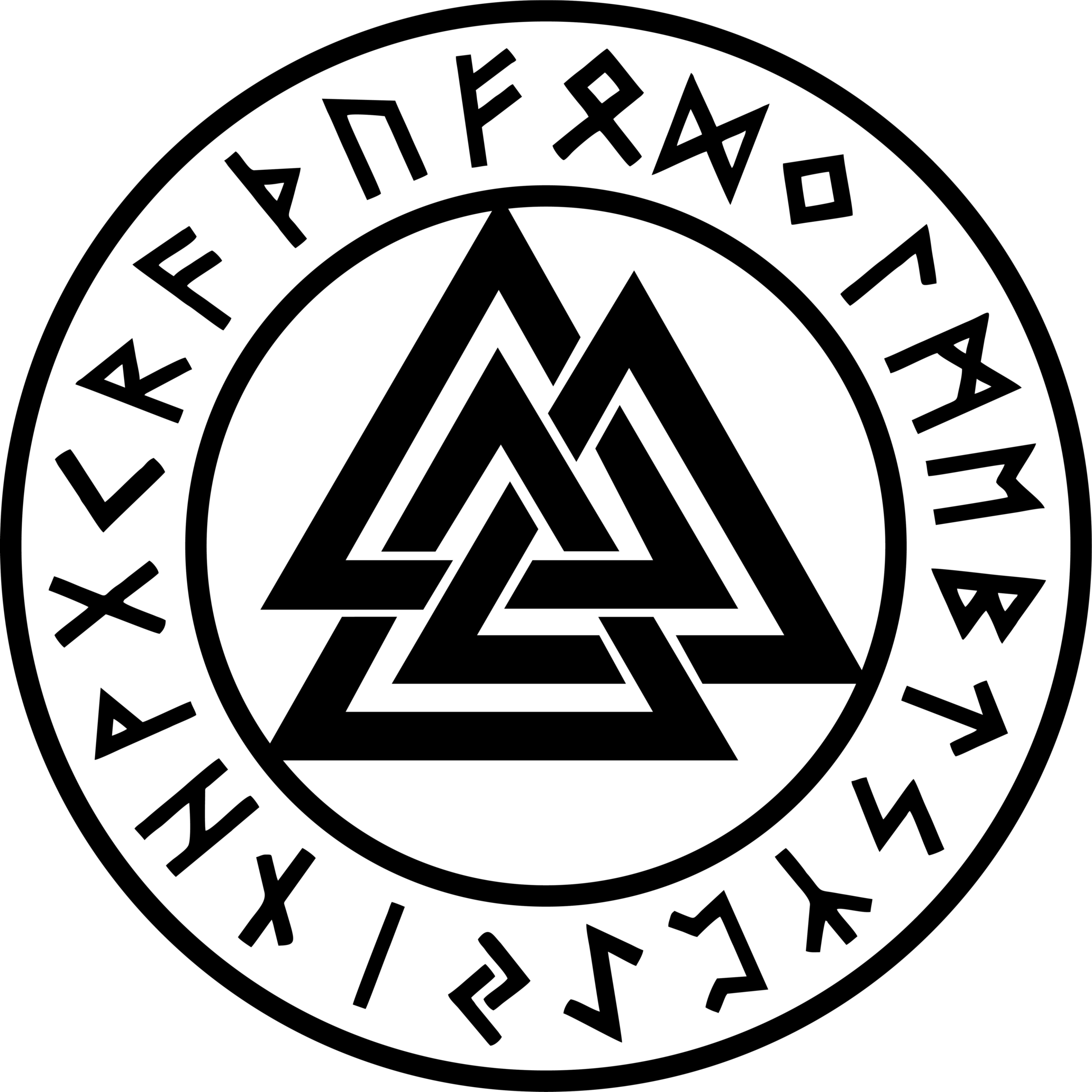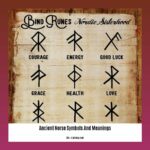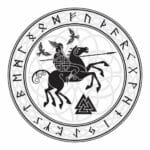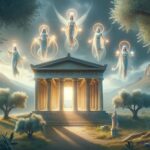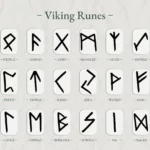Hey there, curious minds! Let’s dive into the captivating world of Nordic symbols. These ancient markings aren’t just cool-looking designs; they’re gateways to a fascinating past. In every symbol, you’ll find whispers of Norse mythology, heroic tales, and the secrets of the cosmos. These symbols are like breadcrumbs leading us through the rich tapestry of our ancestors’ beliefs and traditions. Let’s uncover their hidden messages and unravel the enduring power of Nordic symbols in today’s world.
Nordic Symbols and Their Captivating Meanings
Journey with us into the enchanting realm of Nordic symbols, where ancient wisdom meets modern relevance. These symbols, adorned by Viking warriors and revered by Norse tribes, hold a deep significance that has transcended time.
Emblems of Power and Protection:
In the perilous seas and fierce battles, Viking warriors turned to symbols that embodied their strength and resilience. The Vegvisir, a compass-like symbol, guided them through treacherous waters, while the Aegishjalmur, the Helm of Awe, spread terror among their foes, safeguarding them in the heat of battle.
Cosmic Connections:
Norse mythology painted a vivid tapestry of the universe, and their symbols reflected this celestial tapestry. Yggdrasil, the mighty Tree of Life, stood as a reminder of the intricate interconnectedness of the nine realms, stretching its branches towards the heavens and its roots deep into the underworld. Valknut, Odin’s knot, spoke of the cycle of death and rebirth, a constant reminder of the ebb and flow of existence.
Runic Wisdom:
Runes were more than just letters for the Norse people. They were sacred symbols, each carrying its own unique power and meaning. The Elder Futhark, the most ancient runic alphabet, held 24 runes, each with a distinct essence:
| Rune | Symbol | Meaning |
|---|---|---|
| Fehu (ᚠ) | Cattle | Abundance, Wealth |
| Uruz (ᚢ) | Aurochs | Strength, Courage |
| Thurisaz (ᚦ) | Thorn | Protection, Defense |
A Legacy That Endures:
The influence of Nordic symbols and meanings reverberates through time, inspiring modern artists, designers, and writers alike. Their enigmatic beauty and timeless significance continue to enchant, evoking a sense of ancient wisdom and our profound connection to the natural world.
Embark on a Journey of Discovery:
Immerse yourself in the rich tapestry of Nordic symbols and meanings. Unravel the hidden tales and mythological roots that have shaped these enduring icons for centuries. Their enigmatic beauty and profound significance will leave you captivated and connected to the timeless wisdom of our ancestors.
Do you know what the ancient Norse symbols represent? They were used for protection, strength, and guidance. Find their meanings in this blog Check This Out.
How do Viking symbols reflect Norse mythology and religious beliefs?
Viking symbols are way cool and give us a peek into the beliefs and culture of the Norse people. They’re not just pretty pictures but have meanings that are super important in their mythology and religion.
Think of these symbols as the Norse people’s way of expressing how they saw the world and their connection to it. Vikings believed in gods and goddesses, like Thor and Odin, and thought that the world was made up of nine different realms. These beliefs show up in their symbols, which stand for things like strength, protection, and guidance.
One of the most famous Viking symbols is the Vegvisir, which is like a compass for Vikings. They thought it helped guide them through dangerous waters and keep them safe on their journeys. Another cool one is the Aegishjalmur, which translates to “Helm of Awe.” It was supposed to make enemies run away in terror!
The Vikings also had a big tree called Yggdrasil, which they thought was the center of everything and connected all the realms. They even had a symbol for it that looks like a giant tree with roots and branches that stretch into different worlds.
Another significant symbol is the Valknut, also known as Odin’s knot. It’s like a triangle with three interlocking triangles inside and represents the cycle of death and rebirth. This was important to them because they believed in Valhalla, a place where warriors who died in battle would go to party forever.
Vikings didn’t just use these symbols in battle. They also put them on everyday things like jewelry and clothing to connect with the divine and ward off bad stuff. And even today, Viking symbols still show up in art, fashion, and even TV shows, reminding us of our ancient Viking heritage.
What practical and spiritual purposes did Nordic symbols serve?
In the world of ancient Norse people, symbols played a crucial role in guiding their lives – both in the physical world and the realm of the spirit. Carved into weapons and armor, etched on amulets and jewelry, these symbols were not just decorative but rather infused with deep meaning and purpose.
Shield of Protection
When Viking warriors marched into battle, they carried symbols like the Aegishjalmur, known as the Helm of Awe. This symbol, painted on their foreheads, was believed to strike fear into their enemies and protect them from harm. Similarly, the Vegvisir, or Viking Compass, adorned ships and shields, guiding seafarers through treacherous waters and ensuring safe journeys.
Connection to the Cosmos
Norse symbols also connected people to the larger web of life. The Web of Wyrd, for instance, represented the intricate tapestry of fate, linking the past, present, and future. It reminded people that their actions had consequences and that they were part of a grander scheme. Another symbol, Yggdrasil, the Tree of Life, represented the entire universe, connecting the realms of gods, humans, and the dead. It fostered a sense of unity and a deep connection to nature.
The Cycle of Life
The Valknut, or Odin’s knot, symbolized the god’s power over life and death. It was often associated with Valkyries, who carried fallen warriors to Valhalla, Odin’s afterlife. The Valknut represented the cycle of birth, death, and rebirth, reminding people of their ultimate destiny.
Key Insights:
- Nordic symbols had both practical and spiritual functions.
- They provided protection in battle, guided travelers, and fostered connections with the divine.
- Symbols like the Aegishjalmur and Vegvisir offered tangible support in dangerous situations.
- The Web of Wyrd and Yggdrasil represented interconnectedness and the cyclical nature of existence.
- The Valknut symbolized the journey of life, death, and beyond.
Through these symbols, the Norse people found comfort, guidance, and a deeper understanding of their place in the world. Today, these symbols continue to fascinate us, offering glimpses into the rich spiritual traditions of our ancestors.
How can exploring Nordic symbols enhance our understanding of Viking culture?
Dive into the captivating world of Nordic symbols and unveil the rich tapestry of Viking life! These enigmatic designs weren’t just pretty pictures; they were the Vikings’ way of expressing their beliefs, values, and dreams.
Unlocking the meanings behind these symbols is like solving a puzzle that leads us deeper into the Viking mindset. Just imagine yourself as an explorer, discovering a Viking amulet with the mighty Thor’s hammer etched on it. That’s Thor’s secret weapon, a symbol of strength and protection that Vikings called on in battle.
But there’s more to Nordic symbols than just gods and goddesses. Yggdrasil, the World Tree, symbolizes the interconnectedness of everything, reminding Vikings of their place in the grand scheme of things. And Valknut, Odin’s knot, represents the journey from death to rebirth, a reminder that even in the darkest times, there’s always hope.
By studying these symbols, we can see how they influenced every aspect of Viking life. They adorned weapons, shields, jewelry, and even ships. It’s like reading a secret code that tells us about their fears, their aspirations, and their incredible storytelling abilities.
Exploring Nordic symbols is like embarking on a time travel adventure. It’s a chance to connect with a culture that’s rich in history and meaning. So next time you see a Viking symbol, don’t just admire its beauty. Take a moment to ponder its significance and unravel the secrets of the Vikings’ fascinating world.
FAQ
Q1: What is the significance of Nordic symbols?
A1: Nordic symbols hold profound cultural and spiritual meanings, representing the beliefs and values of the Norse people. They encompass deities, power, protection, and guidance.
Q2: Which are some of the most common Nordic symbols?
A2: Notable Nordic symbols include Mjolnir (Thor’s Hammer), Valknut (Odin’s Knot), Yggdrasil (the Tree of Life), and Vegvisir (the Viking compass). Each symbol carries distinctive meanings and associations.
Q3: How were Nordic symbols used in Viking culture?
A3: Nordic symbols played a significant role in Viking culture. They were carved on weapons, armor, jewelry, and various objects. The symbols served as talismans for protection, invoked deities, and symbolized the wearer’s identity and beliefs.
Q4: What is the meaning of Yggdrasil in Norse mythology?
A4: Yggdrasil, the Tree of Life, is a central element in Norse mythology. It connects the realms of Asgard, Midgard, and Hel, representing the interconnectedness of the world. The tree is often associated with wisdom, knowledge, and the cycles of life and death.
Q5: How did Nordic symbols influence modern Scandinavian culture?
A5: Nordic symbols continue to have relevance in modern Scandinavian societies. They are incorporated into art, design, and literature, embodying cultural heritage and spiritual practices. The symbols serve as a bridge between the past and present, connecting people to their ancestral roots.
- Unlock 6000+ words beginning with he: A comprehensive analysis - April 20, 2025
- Mastering -al Words: A Complete Guide - April 20, 2025
- Master Scrabble: High-Scoring BAR Words Now - April 20, 2025
